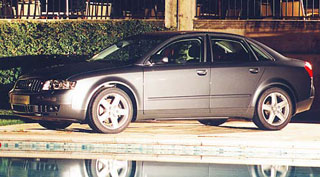Test drive Audi A4 B5 1994 - 2001 sedan
The dispute of excellent students
Four generations of the BMW of the third series over the past quarter century served as the standard of a prestigious sports sedan. This fall, three strong applicants for this role appeared at once: Audi A4, Mercedes C and Volvo S60.We could not attract the latest Audi A4 to tests, since this model is not yet in Moscow salons. The previous generation of Mercedes C (W202), like its predecessor Mercedes 190 in the 2011 body, has long competed with the third series, but only in the nomination of prestigious sports sedans were much less. The new generation of Mercedes C (W203), judging by the first estimates of the European press, became much closer to BMW in terms of satisfying driver's ambitions. The most important technical step in this direction was the abandonment of the steering mechanism such as a ballpoint nut in favor of a gear rack. Another noticeable innovation in the design is replaced by a double -leaf front suspension with a swinging candle. However, the rest of the car was completely updated. Only the classic layout and part of the motor gamut were preserved.
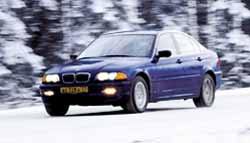 With the S60 model, Volvo, perhaps, for the first time dared to climb into the territory of the BMW of the third series. From a technical point of view, the S60 is interesting in that it is built on the platform and units of larger front -wheel drive models V70 and S80 (while the base, and, especially, the overall length were significantly shortened). The sports nature of the car is emphasized by the fact that the weakest engine is a 140-horsepower, 2400-cubic in-line five, unlike BMW with a smallest engine of 1.9 l 105 hp. Volvo S60 does not have, at least for now, and diesel engines, which significantly weakens the position of the Swedish model in the fight against Mercedes and BMW in the European market. As for the last generation of the last generation of the BMW of the third series (E46) that appeared 2.5 years ago, both in the aesthetic and technical terms it became the evolution of an extremely successful predecessor (E36). At the same time, the treshka became more comfortable and refined, having lost a little in the sports of behavior.
With the S60 model, Volvo, perhaps, for the first time dared to climb into the territory of the BMW of the third series. From a technical point of view, the S60 is interesting in that it is built on the platform and units of larger front -wheel drive models V70 and S80 (while the base, and, especially, the overall length were significantly shortened). The sports nature of the car is emphasized by the fact that the weakest engine is a 140-horsepower, 2400-cubic in-line five, unlike BMW with a smallest engine of 1.9 l 105 hp. Volvo S60 does not have, at least for now, and diesel engines, which significantly weakens the position of the Swedish model in the fight against Mercedes and BMW in the European market. As for the last generation of the last generation of the BMW of the third series (E46) that appeared 2.5 years ago, both in the aesthetic and technical terms it became the evolution of an extremely successful predecessor (E36). At the same time, the treshka became more comfortable and refined, having lost a little in the sports of behavior. Before starting a story about the tests of three competitors, you have to complain about circumstances and apologize to the reader for the not entirely correct selection of modifications of tested cars. Volvo went to the most powerful modification T5 (2.3 l, turbocharged, 250 hp) with a manual gearbox. Mercedes C 320 (3.2 l, 218 hp) is offered only with a 5-speed automatic, and the latest BMW 330i (3.0 liters, 231 hp) could not find and therefore were satisfied with the model 328i (2 , 8 l, 193 hp) with an automatic box. It would be more correct, of course, to choose a Volvo with a machine gun, and a BMW with a new 3-liter engine.
As we expected, Mercedes C 320 turned out to be much more expensive than its rivals. Its price in Moscow, depending on the level of equipment, ranges from 55-63 thousand dollars. The Volvo S60 T5 costs 42-48 thousand dollars, and the BMW 328i 41-46 thousand dollars. The latest modification of the BMW 330i will be approximately 2 thousand dollars more expensive.
Appearance, interior
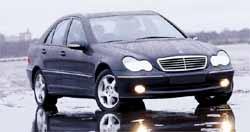 Three heroes of this test are an excellent illustration of how much the cars of the same dimension, maintaining indisputable attractiveness and modernity, may differ from each other. In the appearance of each of them, the genes of their company are clearly guessed. The appearance of the BMW 328i is the least revolutionary in relation to the previous model, while recalling both her and the current BMW of the fifth series. Mercedes C 320 is very different from the previous C-class and is most like a modern Mercedes S. Without a direct predecessor, Volvo S60 resembles a Volvo S80 with its appearance. Objectively evaluating the degree of attractiveness of each of the three cars is almost impossible for everyone good in its own way. It can only be noted that BMW has the most modest appearance (does not mean that inexpressive), Mercedes has the most elegant, and Volvo has the most sports-trendy.
Three heroes of this test are an excellent illustration of how much the cars of the same dimension, maintaining indisputable attractiveness and modernity, may differ from each other. In the appearance of each of them, the genes of their company are clearly guessed. The appearance of the BMW 328i is the least revolutionary in relation to the previous model, while recalling both her and the current BMW of the fifth series. Mercedes C 320 is very different from the previous C-class and is most like a modern Mercedes S. Without a direct predecessor, Volvo S60 resembles a Volvo S80 with its appearance. Objectively evaluating the degree of attractiveness of each of the three cars is almost impossible for everyone good in its own way. It can only be noted that BMW has the most modest appearance (does not mean that inexpressive), Mercedes has the most elegant, and Volvo has the most sports-trendy. The proprietary stylistics also applies to the design of the interiors, however, in Mercedes and BMW, a noticeable national resemblance to Mercedes and BMW: the classic layout of the dashboard with the selected instrument combination case and the traditional dark gray upholstery. Volvo is sharply different in the shape of the dashboard and the beige color of the upholstery. Surely there are admirers of both the restrained-salt German style and the more cheerful Swedish. Moreover, the quality of interior decoration is almost equally high level.
Ergonomics, capacity
It is not surprising that all three cars have a richest set of driver's seat adjustments and a steering column, which, in turn, provides an optimal pose for drivers of various buildings. Differences were found in the form of seats. BMW was the weakest side support, so we strongly recommend the factory option of sports front seats in sporting customers of the third series (and such). The Mercedes C 320 Side support for the seat of the seat is more developed, but it is better than all the driver of Volvo, it deeply covers and gently but reliably holds the body. The Volvo has a wide and highly inclined front stand significantly worsens visibility.
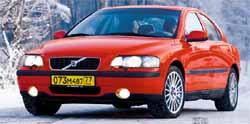 We expected that the front -wheel drive Volvo S60, which is also longer and wider than Mercedes and BMW, would have a significant advantage in the capacity of the passenger salon. In fact, this spatial gain is not very large, and a comfortable driver in 190 cm tallly settled, he will significantly constrain a passenger sitting behind him in each of the three cars. All three are far from the reference in capacity in this class VW Passat. Three competitors are surprisingly close in terms of volume, form, and in the general drawback of a short opening of the trunk cover, which limits the possibility of loading large objects.
We expected that the front -wheel drive Volvo S60, which is also longer and wider than Mercedes and BMW, would have a significant advantage in the capacity of the passenger salon. In fact, this spatial gain is not very large, and a comfortable driver in 190 cm tallly settled, he will significantly constrain a passenger sitting behind him in each of the three cars. All three are far from the reference in capacity in this class VW Passat. Three competitors are surprisingly close in terms of volume, form, and in the general drawback of a short opening of the trunk cover, which limits the possibility of loading large objects. Acceleration dynamics, braking
The most impressive dynamics of Volvo S60 T5. The difference between him and experienced competitors is much greater than this is indicated by the acceleration figures to 100 km/h. Which is understandable at the start of the front-wheel drive, 250-horsepower Volvo more than the rear-wheel drive analogues, is prone to slipping the drive wheels. The anti -operating system, of course, helps, but also eats a fraction of a second. Moreover, its shutdown does not accelerate the acceleration process, but only leads in the ambulance to an expensive replacement of tires. By the way, the anti -industry, with intensive operation, causes unpleasant strong vibrations of the entire car. But all these are trifles against the backdrop of a magnificent pickup, you can say a shot that provides the motor in motion. The engine begins to demonstrate its capabilities already from 2500 rpm, smoothly moving to a hurricane return to 3500-4000 rpm, and so on to the very red tachometer zone. Overfigure is turned into children's fun, and the requirements for the correct choice of transmission are minimal. An important advantage is that all this power is distinguished by smooth work, which is easily controlled by the accelerator pedal. And only a small drop of tar to this barrel with honey adds a clutch pedal with a stretched course of inclusion and the lack of information content by effort. By the way, the execution of the gear lever in the form of a large ball hinge is a pure decoration that does not add clarity to the switching process.
So, the entire section turned out about Volvo, and meanwhile, both the BMW 328i, and the Mercedes C 320 in the dynamics of acceleration, honestly met our expectations, demonstrating good traction and smooth operation of automatic gearboxes, with a useful addition in the form of a manual control regime. As expected, Mercedes turned out to be a little more dynamic than a BMW with a smaller engine. It remains only to recall once again that the BMW 330i is a more suitable analogue for the Volvo S60 T5 and Mercedes C 320.
It is interesting that the noise from such different motors during intensive acceleration is almost equally small, and the timbre of voices is not very different from each other. It is difficult to find fault with the work of brake systems of all three cars, we only note that the traditional Mercedes footman is slightly unusual for owners of other cars.
Manageability, smoothness
Front -wheel drive 250 hp They can negatively affect not only the dynamics of acceleration, but also on handling. And past experience with Volvo brutal models (S40 T4 and S70 T5) confirmed this quite clearly. Volvo S60 T5 demonstrated significant progress in this area. The steering has acquired some information content and quite decent sensitivity. The rotation of the car is close to neutral, and even on the slippery winter road, Volvo did not show an excessive tendency to loss of adhesion of the front wheels on the coating. Despite the supern Wealthy tires (225/45-17), the smoothness of the course can be estimated as acceptable.
And Volvo would look quite worthy, if not for the German opposition. Both BMW and Mercedes showed the highest level in conjunction control. Both cars are not stable on the ice and snowy road. The beginning drift is instantly eliminated by electronics. The steering is accurate and very informative, although in the central zone it could have been more award (we are talking about two cars at once they are so similar). And all this against the background of excellent smoothness. Without rolls and swinging of the BMW and Mercedes suspension body, relatively short, but energy -intensive moves of elastic moves are treated most of the irregularities of our roads. Based only on winter driving, it is difficult to even determine which of them is better. Be sure to try to do this in the summer.
Results
All three brands are well known in Russia, and for a significant part of buyers, the choice of one of the tested cars will be based simply on the commitment to the manufacturer. Another motivation may be the price: Mercedes is much more expensive than Volvo and BMW. The basis for choosing can be the appearance of each of the three cars, it is expressive and interesting in its own way.
If you are a lover of explosive dynamics of acceleration, then your choice of Volvo. If, however, a combination of good smoothness and honed controllability is more important to you, then you need to choose between Mercedes and BMW. In conclusion, it must be emphasized that there are no weak or at least ordinary cars among the tested trinity, and choosing any of them, you are unlikely to be disappointed.
Roman Sergeev
Photo by Alexander Nozdrin
How do they look:
Nikita Rozanov

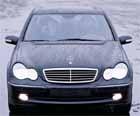

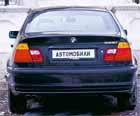
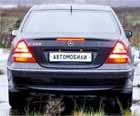

Outside:
The style of this whole trinity is well familiar, and you only need to see any of it for a moment, as the company is identified right there, and after another moment and model. Although the model is more difficult, because rapprochement to the dangerous similarity of the appearance of the gamma of large manufacturers is one of the most characteristic modern design trends. And, for example, the appearance of Mercedes C has a lot of borrowings from the design of the flagship of the company S, the third series of BMW has come close to the fifth, does not lag behind these manifestations of families and Volvo. At the same time, the personality of the design has always been very highly valued, and those who managed to declare themselves in this consumer quality relate to the style of jealously and even conservatively. Therefore, Volvo can be considered in this company as a kind of beginner, especially since the design developed by the Englishman Peter Horbury (Peter Horbery) compared to the historical appearance of Mercedes and BMW and really looks fresh and young.
The front of the car to the person stylists, according to the laws of the genre, always try to give maximum originality and recognition. And here all three nominees are the same in a good way, because they use the historical motives of the previous claders of radiators from those distant years when, having unscrewed the cork with a proprietary emblem, water was poured into these radiators. Optics is also very characteristic, although here the shape varies around the topics of double headlights: from covered with a common covering glass on BMW to flowing into each other, like drops of mercury, Mercedes. The shape of the main volume of the body of all three cars was clearly optimized in an aerodynamic pipe, but, despite this, the individuality of each machine was preserved. In particular, the Volvo body with the dominant seizure of the window line of the window sill, connecting the radiator lining and ruby \u200b\u200bcrystals of the rear lights with a dynamic stroke. The silhouettes of BMW and Mercedes are less avant -garde, but thanks to small plastic features, it is easily remembered. So, BMW is traditional in the filling of medium racks in black and a very characteristic shape of the reverse bastard of the rear rack (C). Mercedes also masks the middle rack, achieving visual similarity to the sports compartment, but still increases the dynamics of the sidewall of the arrow -shaped lining, which is effectively interrupted at the very front wheel arch. At the back, all three cars are identified as easily as in front, but here the explicit leader of Volvo, whose unique rear lights have three faces of the surface instead of the usual two and, in this regard, mysteriously gleam even in the state of not included.
Bottom line: BMW 328 solid and very characteristic design, which is perceived by the next modernization of the three. In this regard, the inevitable share of conservatism slightly reduces the efforts of stylists aimed at achieving the sports and dynamic image of the car.
Grade: ****
Mercedes-Benz C A solid and easily recognizable design with pronounced elements of proprietary affiliation. However, too straightforward use of style techniques and details borrowed from other models of the family, leads the design of the model to a dangerous face of an excessive mechanistic shape formation.
Grade: ****
Volvo S60 Although the design of the model carefully repeats the shape and drawing of the S80, C70 and V70, it retains originality and is fully consistent with the place of the model in the name Volvo and its new image.
Grade: *****
Inside:
The interior of all three cars of the test participants is organized in full accordance with the sports orientation of models. However, just like outside, the BMW interior is perceived a little more conservative. A two -color finish of the instrument panel and a somewhat archaic shape of the four -spoke steering wheel work for this. The interior of Mercedes is classically luxurious and multifunctional in S-class. The same complexity of organizing the central console and the apparent ingenuity of the algorithm of the buttons of electrical adjustment of the seats located next to the door handle. Without a doubt, Volvo design is a cut above competitors. It is more modern and in Scandinavian more concise and is inferior only in the quality of finishing materials used on seats and upholstery of the doors. For example, in the modification of the S60 T5, the alternation of black and light finishing materials creates excessive variegation, which does not go well with the exquisite laconicism of the design of the central console and the spaceship of the gear lever. Great plus Volvo, his family orientation in the equipment of the interior. For example, a place for a middle passenger on the back sofa can be transformed into a children's seat, and full -fledged ventilation and heating defrosters for rear passengers are implanted into the middle racks. BMW and Mercedes trunk are traditionally isolated from the cabin. In Volvo, the trunk is more reminiscent of the Hatchbekovsky, has a very thorough finish, many devices for fixing the luggage, as well as two handles in the side walls, with which you can lower the back of the rear seat and transport a long load.
Bottom line: BMW 328 is a very high -quality and solid interior execution with a slightly outdated plastic and color gap in the instrument panel.
Grade: ****
Mercedes-Benz C traditionally high manufacturing quality and care of the selection of materials for this company are adjacent to the oversaturation of details and some overclocking.
Grade: ****
Volvo S60 is a modern and laconic design in full accordance with the class and the purpose of the car.
Grade: *****
How they sound:
Maxim Rakitin
Volvo S60
Our readers already know that Volvo has recently equipped their cars with music in the highest category. S60 is no exception. The head device is a combination of the tuner and the CD player. In appearance and set of functions, it completely repeats the head on Volvo XC (cars No. 12/2000). The difference between the number of speakers has grown up to 11 pieces. The instrument panel, in the full sense of the word, decorates the central speaker of the Dolby Prologic system, which is confirmed by the inscription on one of the functional buttons. In order to evaluate the sound of 11 speakers in the S60 salon, you need to stock up on a small collection of CDs. Let it be rock Foo Fighters, classic Ravel and rhythm-end-blouse Lauren Hill. The system of this class, of course, is equipped with a digital sound processor and a built -in equalizer with a set of fixed settings.
Start. 3 Dolby channels, 11 columns and rock is real and heavy. As stated in one commercial, I did not hear such bass even in the most powerful thunderstorm. The well -used acoustic space of the cabin allows low frequencies to remove amazing wave -shaped roulads, from which glass rattles and the heart pounds. True, the middle is almost lost behind these roulads, but if you make it quieter, this disadvantage is eliminated. Ravel sounded no worse than in the conservatory, it was even heard how the bow touches the strings, and the musicians fidget on chairs. Each tool is heard clearly and easily recognizable. But completely all the possibilities of Volvo music were opened only on R&B Loren Hill. The famous polyphonic state gospel quickly roll along the cabin, wandering into every hidden corner. Probably, even in the glove compartment you can hear how every speaker practices one hundred percent.
It is unfortunate that there was no color monitor and DVD player at hand. With such opportunities, the S60 could also become a very good cinema for five.
BMW 328
The Bavarians are not conceited people, but they have been calling Bavaria for a long time in their cars. Inside the BMW branded systems from Blaupunkt and VDO. Moreover, BLAU supplies speakers, and VDO collects head devices. Our boomer was equipped with the Bavaria Business system. This means that the system consists of a tuner, a cassette player and a CD changer. Acoustics are high -quality dynamics. Ahead is separate with crossovers (150 W), three -lane coaxial (200 W) behind. The tuner accepts FM and AM ranges. All information about the operation of the head device is displayed on a long and wide display. Strange, but with large sizes, it gives out only a minimum of information.
RDS with PTY, TA and TF modes. The stations are located in 24 cells of 4 memory banks and set up in automatic and manual mode. When automatically tuned, the tuner tries to grab the stations and arrange them sequentially from the lower frequency to the highest. The cassette part is not hidden under the decorative lid. The cassette nest is highlighted around the entire perimeter, and next to it there are buttons of release and turning on the Dolby b noise control system. This Bavarian farm works clearly and smoothly. The controller control of the cassettes is completely logical. The search for the desired disk and the track on the CD chain located in the trunk takes a matter of seconds. The pendulum mechanism successfully fights with failures that arise on numerous bumps.
BMW 328 once again proved that VDO and Blaupunkt create a sound oriented to the classics. The soul fluttered from the disk with Raven and knees shook, it makes its way so. You need to thank the speakers with a clearly expressed middle and slightly muffled bass for this. Rock also sounds good, but these compositions do not have the right drive and pressure. So, the Germans made special music for the connoisseurs of the beautiful.
Mercedes with 320
There were times when Becker's radio tape recorders installed on MV. Simple design and excellent sound were pleased with several generations of merin owners. The current Mercedes preserved and increased the glory of the sound technique of predecessors. The C-class has the whole tuner with AM and FM ranges, a cassette player and a CD changer in a glove compartment. The tested car has 8 speakers. 2 separate in the front doors, 2 in the rear and 2 in the rear shelf. In its design, the header of the chain is very reminiscent of its ancestor, the same beCker. Everything is very simple, functional buttons are grouped in one place, service in another. True, it is not very convenient that the buttons are too close to each other, and it is not always possible to activate the desired function to the touch.
The tuner perfectly accepts all stations, and in the zones of uncertain reception automatically goes into Local mode. What should not be done on the go is to fill in memory banks, because for this you have to operate with several buttons. RDS recognizes all known types of programs and automatically switches to transmit road information if the function is enabled. Preparation of the tape -to -pass mechanism of the cassette for work takes a couple of seconds. Of course, the control is fully automated. The cassette operates in Intro modes (the first 10 seconds of each track), SKIP (pass of empty places), searching for pauses and repeat. Chainer in a glove box thing is very convenient, especially if there are two in the car. The front passenger can easily change the wheels in a bun with six holes. Since Chainer is firmly fixed in the glove compartment, a pendulum suspension and a buffer for 10 seconds saves him from all road adversities. It should be especially noted that in MV the sound quality of both cassettes, and CD is very close to each other. The magnetic head with a three -layer coating practically nullifies the advantage of the laser beam. And the balance of the system allows you to listen to jazz, rock, and popes with the same pleasure. Foo Fighters, Ravel and Loren Hill sounded almost perfectly.
Source: Cars
Video Crash tests Audi A4 B5 1994 - 2001
Test drives Audi A4 B5 1994 - 2001
Crash Test Audi A4 B5 1994 - 2001
Krassh Test: Detailed Information17%
Driver and passengers








